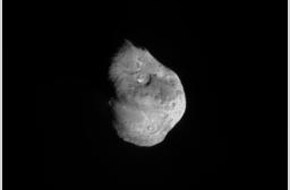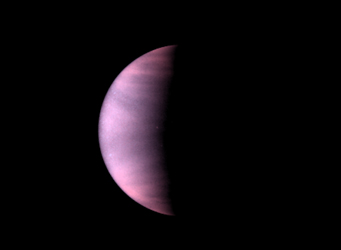
This image shows comet Tempel 1 six minutes before it ran over NASA's Deep Impact probe. The picture was taken by the probe's impactor targeting sensor. Another NASA comet craft, Stardust, might rendezvous with this dirty snowball to see how it has evolved since the 2005 encounter.
Courtesy NASA/JPL/Caltech/UMD.
There were no tricks, just treats for NASA scientists on All Hallows' Eve. Not only did NASA administrator Michael Griffin breathe life back into the Hubble Space Telescope by reinstating the once-canceled servicing mission, the space agency also announced the latest round of Discovery-class missions to receive funding. From approximately two-dozen entries, six projects were selected for concept studies: three new missions and three proposals for extensions of existing missions. If they survive the concept-study round, the new missions will receive up to $425 million, while the extended missions will receive up to $35 million.
One of the new missions to receive concept-study funding is the Origins Spectral Interpretation, Resource Identification and Security (OSIRIS) craft. Headed by Michael Drake (University of Arizona), the mission will survey an asteroid and bring samples from the surface back to Earth. Also approved is the Vesper mission — a Venus orbiter that will study our cloud-shrouded sister planet's atmospheric composition and dynamics. The lead scientist for that craft is Gordon Chin (NASA/Goddard Space Flight Center). Third on the docket is a new Moon mission called the Gravity Recovery and Interior Laboratory (GRAIL). Maria Zuber (Massachusetts Institute of Technology), head scientist for the spacecraft, will use the craft to make gravity maps of the Moon to determine our satellite's interior structure.

A crescent Venus as seen in ultraviolet light by the Hubble Space Telescope. Another proposed NASA mission would send a craft to study our sister planet's atmsophere.
JPL
NASA officials announced three more selections that could extend the lifetimes of missions already in space. The first two involve the Deep Impact comet-rendezvous spacecraft. The Deep Impact eXtended Investigation of Comets (DIXI) will fly past a second comet (85P/Boethin) in 2008, and take pictures of its nucleus. As he did with the previous Deep Impact mission, University of Maryland scientist Michael A'Hearn is leading the team.
Deep Impact's high-resolution camera will also be put to new use hunting for planets outside of our solar system. L. Drake Deming (Goddard) will use the instrument as part of the Extrasolar Planet Observations and Characterization (EPOCh) mission. Deming's goal is to locate Earth-sized planets around other stars.
Finally, the Stardust spacecraft will be put to new use too. It will rendezvous with Deep Impact's old target, comet Tempel 1. The plan is to revisit the impacted comet and see how the dirty snowball has changed since the Deep Impact mission visited it in July 2005. The mission, headed by Joseph Veverka (Cornell University) will also examine the characteristics of the crater left behind from Deep Impact's "impactor."
 0
0
Comments
You must be logged in to post a comment.